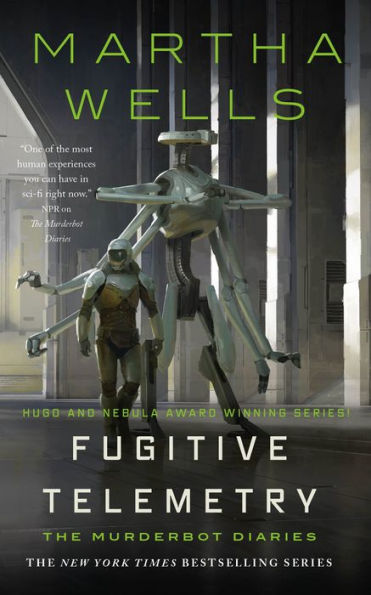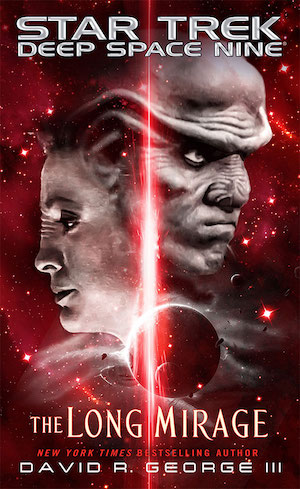The Long Mirage
David R. George III
Publication Date: February 2017
Timeline: January 2386, following The Fall: Revelation and Dust, Sacraments of Fire, and Ascendance
Progress: In a brief prologue, the Bashir 62 holosuite program provides the environment for a waitress in a Las Vegas diner to witness a conversation between two characters we will later figure out are Morn and Vic Fontaine.
In the novel proper, we have four main interconnected story threads:
(1) After the original DS9 was destroyed, Vic Fontaine’s program continued to run in a temporary simulator, and since then Nog’s efforts to fully restore its functionality on the new starbase have met only with partial success. Nog is concerned that Vic’s program could cease to function, and he’s keen on not resetting Vic to his “factory settings,” since that would remove Vic’s memories and destroy the specific personality that Nog has come to know and love. Nog and John Candlewood, who despite Nog’s comments to the contrary, really thinks of Vic as merely software, doggedly pursue the matter. Vic’s been kidnapped, and their search isn’t greeted warmly by various parties.
After some false starts, with the help of original program designer Felix Knightly, they use a “back door” to re-enter the program and have one week to get to the bottom of things. They learn from Ulu Lani—who isn’t really just a dabo girl, but someone in Morn’s employ—that Morn and Vic developed a friendship over the years. Vic tried to help with Morn’s gambling woes, but eventually things took a turn for the worse, and Morn went off in search of a way of alleviating the situation from outside the holosuite. Working within the confines of a very specific ‘60s-era Las Vegas, Candlewood and Nog have to generate a ton of money to prevent Vic from being killed by the mob.
(2) Quark has hired private investigator Mayereen Viray to locate Morn because he’s genuinely worried about him. But when Viray is apparently kidnapped, Quark suspects that he’s been played by her for latinum, and so he decides to track her down himself. After asking Ro for help, he’s pleasantly surprised when she personally joins him on his quest. But it’s not all good news—part of Ro’s reason for teaming up with Quark is not to be with him, bur rather to get some time away from DS9, where her new romance with Altek Dans has hit rough waters [see 3)]. In fact, Ro makes it clear she doesn’t see herself in a long-term relationship with Quark going forward, and he’s understandably upset.
Nevertheless, they proceed on their mission, eventually locating Viray and Morn, and in turn Federation agents Corvok and Toulet arrest the latter. Morn has apparently gotten his hands on twenty-ninth century specs, though he’s used twenty-fourth century means to make those specs real, in an attempt to build an independent holo-emitter for Vic that will free him from the holosuites forever. Since there’s possible time travel repercussions involved, the Department of Temporal Investigations takes an interest.
Buy the Book


Fugitive Telemetry
(3) After a two-year disappearance, Kira re-emerges from the wormhole and makes her way to the new DS9 starbase. With her identity thoroughly confirmed, she shares with Ro her experiences living an alternate life inside the wormhole, and the events leading to her involvement with the Ascendant storyline and the Even Odds prior to re-entering it. When she meets Altek Dans, who is spending time with Ro, Kira and Altek immediately remember their past shared life in what we’ll later learn was another reality. That life included a close romantic relationship. When Ro learns of this, she needs some distance from Altek. Kai Pralon on Bajor has Kira and Altek travel to the planet, and attempts to use each of them to unify the Bajoran people, who have been split ever since the Ohalavaru arose. Kira and Altek go on to help explore the Endalla falsework, and Kira realizes that Altek is a Hand of the Prophets, sent to provide a refutation of the Ohalavaru claims.
(4) Zivan Slaine and Jefferson Blackmer detect a Dominion ship, which turns out to be a Jem’Hadar battle cruiser, on its way to the wormhole. Odo, who has been recuperating, returns to DS9 and helps the crew ascertain the nature of the Jem’Hadar vessel. It turns out that a very liberated Weyoun and Rotan’talag are escorting several thousand similarly self-emancipated ex-Dominion citizens who wish to pursue freedom in the Alpha Quadrant.
Altek and Kira choose not to rekindle their alternative-lives romance. After playing his part in the Dominion refugee storyline, threads 3 and 4 link up when Odo makes it to Bajor, tracks down Kira at her monastery, and they reunite.
Ro and Quark, combining threads 2 and 1, are able to help Nog and Candlewood, and end up saving Vic’s life. The mobile emitter doesn’t really take, though, so in the end Vic returns to the holosuite and goes on the lam, leaving Vegas and ending up in France. A scientist determines that Vic is pre-sentient; as such, he can’t be charged with any crimes for his part in Morn’s scheme, and Morn himself is finally released as well.
Behind the lines: There is a warm, beating thematic heart of friendship, loyalty, and doing the right thing in this ambitious novel, but it’s significantly cooled by often lackadaisical plotting and only sporadically effective pacing.
Many of the pleasures, and lack thereof, that I experienced while reading this book are the direct result of how well or not George’s very particular writing style served the needs of each of the storylines mentioned in the summary. In general terms, I thought the prose was most effective with Kira’s storyline. She feels absolutely authentic, based on our years of familiarity with her even beyond this relaunch, and besides simply being a welcome voice after too long an absence, her scenes with Altek and with the Kai were able to illuminate compelling ideas. Kira’s strength is in neither giving in to the emotions of her alternate persona nor to the political pressures of a well-intentioned but nevertheless pushy political leader; but she also doesn’t ignore or suppress what happened to her in her other life, nor does she callously disregard the Kai’s desires. Instead, she walks the path that keeps her aligned with her own moral code while, as respectfully as possible, preserving those other relationships. The tensions with the Kai in particular are a standout; complex, realistic, empathetically drawn. They also highlight the import of the falsework revelations. After all this, Kira’s reunion with Odo, though brief, felt not only poignant, but extremely well-earned.
Another thread that benefits from George’s aesthetic sensibility is the dynamic between Ro and Quark. I was initially worried this would get bogged down into melodrama, but I found it surprisingly effective. I think the dramatic strength here stems from the unexpected choice to make Quark the romantically wounded party as well as the more overly sensitive of the two characters. In a way, and counterintuitively, he displays the greater maturity. Ro at least has the self-awareness to identify the problematic way in which she’s behaved, but I wasn’t completely sold on her running away from her problems, so to speak, while simultaneously chastising herself for not being a better adult. This seemed like a step back for her character in a general sense.
The author’s writing unfortunately lacks the pizzazz and humor needed to really bring alive the many long scenes that unfold in the holosuite. Though the Nog-and-Candlewood pairing is clever and pleasing, and Candlewood himself benefits from some solid character development, I often found myself disengaged during these sequences. Cuteness will only take you so far, and George’s dramatic conception of scenes lacks the deftness, for instance, of the two recent outings by Paula M. Block and Terry J. Erdmann. Another virtual escapade, I too often thought, without real stakes (not for a moment did I believe this novel would actually kill Vic). The eventual resolution to this, while again admittedly conceptually intriguing, felt both like overkill (DTI, really?) and fluff (a sort of status quo happy ending). While I appreciate Vic returning to the fold, it wasn’t a plot line I needed expounded over three books. Is he really pre-sentient, or so advanced that he feigned his own pre-sentience? Hmmm.
Amongst the novel’s detail-related busyness, some elements fell flat. Ulu Lani, for example, didn’t come across as particularly well-developed, and the long expository scenes in which she just fills in Morn’s backstory with Vic felt clumsily executed. Though these beats don’t necessarily contradict anything in Rules of Accusation, I preferred that story’s depiction of Morn’s recent shenanigans.
The novel’s closing act contains moments of potential wonder—the exploration of Endalla, for instance—and emotional import (Kira’s conversation with Raiq) but they feel somewhat rushed (some of them are relegated to an epilogue or otherwise recapped). The idea that Altek Dans originated in an alternate reality seemed fairly heavily telegraphed, and I was surprised nobody really seemed to look into this possibility. Furthermore, his cross-reality role in the Prophet’s plan seems underwhelming and convoluted. I appreciate George’s descriptive abilities, particularly when he curbs his natural inclination towards minutiae, and they fare better in this book than in some of his others. Alternating between the four storylines helps. Yet, despite many fine individual moments on the ride, about half of this book’s destinations felt anticlimactic; some leisurely saunters for pretty light snacks.
Memorable beats:
Ro: “… it wasn’t the Occupation that brought the worship of the Prophets to Bajor. My people have believed in Them, in Their divinity, for a long time. Like in many places, there was a need for people to explain the world, to understand life, to cope with suffering and seek a better tomorrow. I lived through the Occupation, so I know how much it impacted Bajor, how great the need for the Prophets was.”
Kira: “I don’t think it’s reasonable to think that we can comprehend the will of the Prophets.”
Altek Dans: “In my experience, people are never so threatened as when facts disagree with their deepest held beliefs—religious or otherwise.”
Kira: “I can’t support barbarous acts or attempts to bring the Bajoran religion or its opposition low, but I defend the rights of people to seek the truth—even if that truth would contradict my own.”
Vic: “I’m grateful to you. But just because this thing worked as a life preserver, that doesn’t mean it can work as a way of life”
Orb factor: Conclusions lacking in the gravitas and dazzle needed to justify the over-abundance of setup found not only here but in the last two volumes by the same author; 7 orbs.
In our next installment: We’ll be back in this space in the new year with Una McCormack’s Enigma Tales!
Alvaro is a Hugo- and Locus-award finalist who has published some forty stories in professional magazines and anthologies, as well as over a hundred essays, reviews, and interviews. Nag him @AZinosAmaro.










